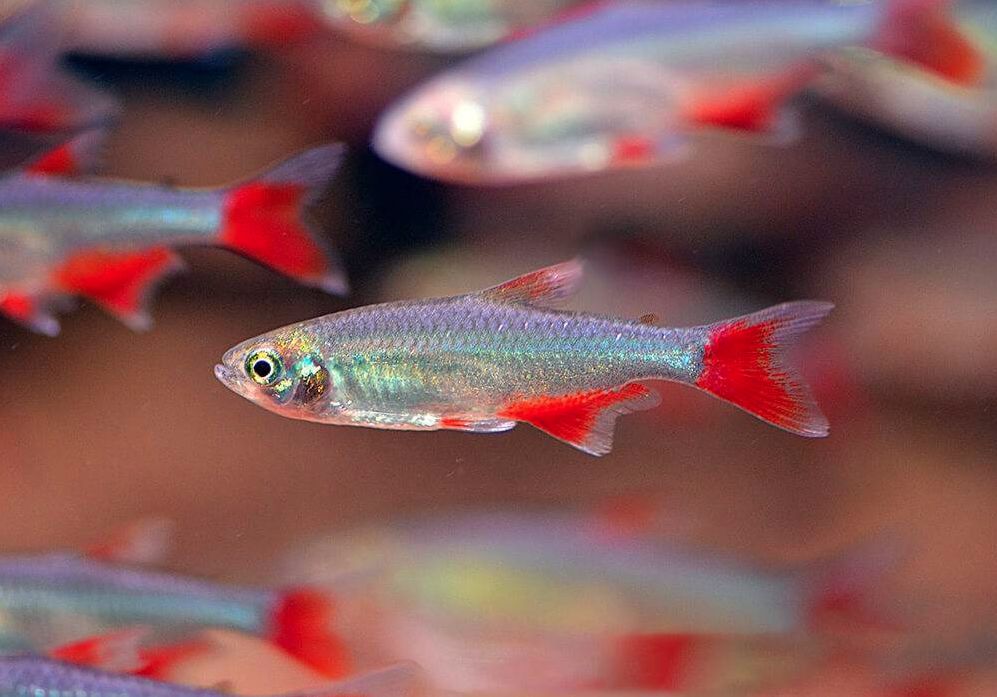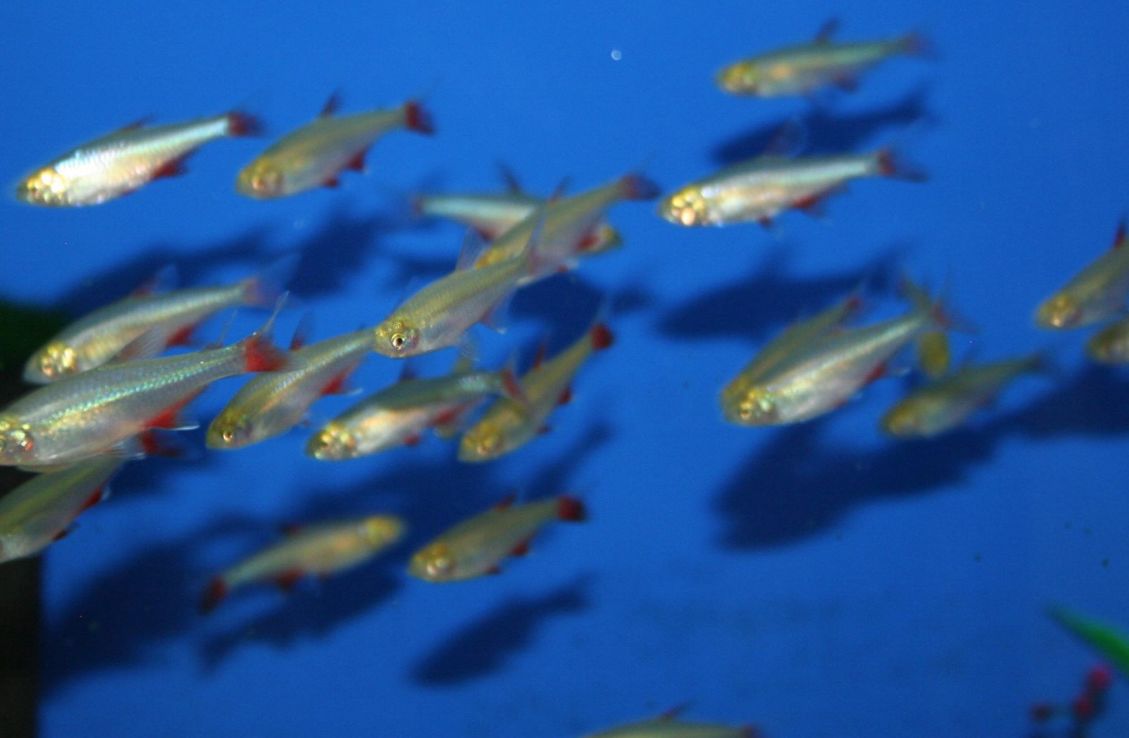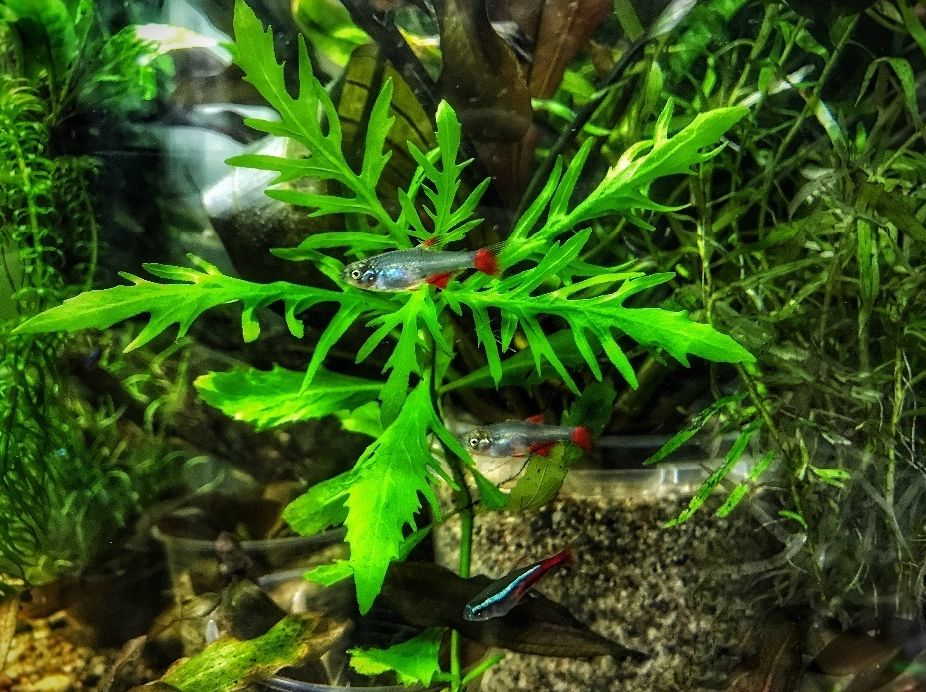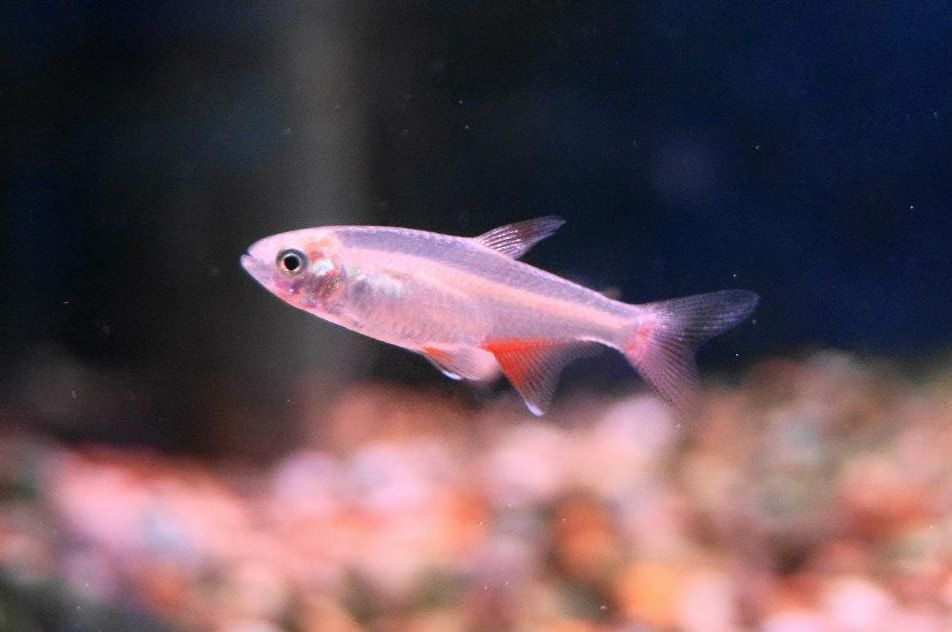Bloodfin tetra (lat. Aphyocharax anisitsi) is a small and active fish of Characidae family. These freshwater fish are perfect for beginner aquarists, since it excellently stands a wide range of tank water parameters. They can live at lower temperatures, than other tropical fishes. Some aquarists even keep them in tanks without heaters at room temperature.

Contents
Habitat in the wild
The bloodfin tetra habitat is in South America, specifically Argentina, Paraguay, and Uruguay. It prefers river tributaries, distributaries, streams and places shadowed with floating plants and hanging vegetation.
Description
Body and color
This fish has greenish body with violet tint, the sides are iridescent. Unpaired abdominal fins base has saturated red coloring, due to which the breed got its name.
The fish scales are rather large. Male fish species have bluish anal fin edges. Besides they have a small hooked outgrowth on the anal fin; the fish quite often gets stuck in a dip net due to it when moving the fish into another volume. When the fish gets frightened or stressed it becomes pale and dim colored.
Size
How big do bloodfin tetras get?
Bloodfin Tetras (Aphyocharax anisitsi) typically grow to a size of approximately 5-5.5 cm (2 inches). This size measurement is based on the average adult size of these fish. However, it’s important to note that individual tetras can vary slightly in size, with some individuals growing slightly larger or smaller than the average. Proper care, nutrition, and a suitable aquarium environment can contribute to healthy growth and development in bloodfin tetras.
Lifespan
How long do bloodfin tetras live?
The average lifespan of bloodfin tetras is typically around 3 to 5 years when kept in proper aquarium conditions. However, with optimal care, some individuals have been known to live up to 7 years or longer. Several factors can influence the lifespan of bloodfin tetras, including water quality, nutrition, genetics, and overall health.
| Characteristic | Description |
|---|---|
| Scientific Name | Aphyocharax anisitsi |
| Common Names | Bloodfin Tetra |
| Origin | South America (Argentina, Paraguay, Uruguay) |
| Adult Size | Up to 2 inches (5 centimeters) |
| Lifespan | 3-5 years |
| Temperament | Peaceful, schooling fish |
| Coloration | Silver body with bright red fins |
| Tank Size | 20 gallons (75 liters) or larger |
| Water Temperature | 72°F – 78°F (22°C – 26°C) |
| pH Range | 6.5 – 7.5 |
| Water Hardness | Soft to slightly hard water |
| Diet | Omnivorous, accepts high-quality flake or pellet food, supplemented with live or frozen foods like bloodworms or brine shrimp |
| Tank Compatibility | Peaceful community fish, avoid fin-nipping or aggressive species |
| Breeding Difficulty | Moderate |
| Breeding Method | Egg-scattering spawner |
| Preferred Habitat | Slow-moving rivers, streams, and flooded areas with dense vegetation |
| Recommended Plants | Java Moss, Amazon Sword, Vallisneria, Water Sprite, Amazon Frogbit |
| Lighting | Moderate to low lighting levels |
| Recommended School | 6 or more individuals for natural schooling behavior |

Difficulties in keeping
Bloodfin tetra is a peaceful schooling fish; it swims in upper and middle water layers and it can jump out of water if it gets scared. It is a renown fish among aquarists and it is good for the beginners. You can keep the fish in a community tank. The more fishes you have in a school, the more comfortable they feel.
This fish is suitable for beginning aquarists, since bloodfin tetra is a very enduring and undemanding fish.

Care and keeping in tank
Tank size
Minimal tank size is 30 liters for the fish couple, but it’s better to keep them in a school in a large sized tank. School in a tank should be about 6-8 species. The tank should be an elongated one and covered from top, since the fish swim in upper water layer and they are capable of jumping out from the tank. Dark tank bottom substrate is preferable as well as thickly put tank plants and some free space for the fish to swim.
Water parameters
Tank water parameters are the following: dH up to 20°, pH 6−7.5, 22−26°C (71,6–78,8 °F ) plus regular water renew (¼ from total tank volume). This fish kind can successfully adapt even to living in a tank with water at room temperature, though in cold water the fish coloring becomes paler.
So, the fish is capable of taking water temperature 15-18 °C for some short period of time. At high water temperature (higher than 28 °C) and lack of aeration the fish constantly stays near the water surface and gasps the atmospheric air with its mouth.
Tank decor
It’s desirable to use small sized dark colored gravels as the tank bottom substrate, since against such a background the fish coloring looks especially appealing. Use some dim lighting for the tank and put sufficient number of tank plants, where the bloodfin tetra will hide.
The fish is rather timid, especially when it is kept in a number less than the recommended one. When the fish gets scared its body pigmentation changes essentially, the coloring becomes pale and dim.

Diet
In the wild the fish feeds mainly on worms, small insects. Bloodfin tetra isn’t demanding in terms of food – it actually eats all types of food: live, frozen, artificial ones.
Bloodfin Tetras can be fed a staple diet of high-quality flake or pellet food formulated specifically for tropical fish. Choose products that contain a good balance of proteins, fats, and carbohydrates.
We should mention, that the fish is an omnivorous one and that’s why it is recommended to limit the amount of food you give to it. Feed the fish several times a day, but the amount of food for one meal should be eaten in 3 minutes or even less.
Tank mates
This is a peaceful fish species which is recommended to keep in a group of at least 6 species. At that all their attention and activity will be concentrated inside their group. In case of smaller number of fish species their behavior becomes worse – they may demonstrate aggression towards other fishes in a tank. Especially it is true for slow fishes with long fins (goldfishes, angelfishes).
Bloodfin tetra shows good compatibility with fast fishes like tiger barb or zebra danio. Bloodfin Tetras can be kept with other small Tetra species like Neon Tetras (Paracheirodon innesi), Ember Tetras (Hyphessobrycon amandae), or Glowlight Tetras (Hemigrammus erythrozonus). These species create a vibrant and active community in the aquarium.
Corydoras species, such as panda corydoras or pygmy corydoras, make excellent tank mates. They are peaceful bottom-dwellers that share similar water parameter requirements.
Gender differences: male vs female
The bloodfin tetra almost have no gender dimorphism. You can tell between the male and female fish only when moving them from one tank to another, since the male fish will get stuck in a dim net because of its hooked outgrowth on the anal fin. It is quite difficult to release the fish then. So, not to hurt the fish it’s recommended to use a plastic container for this purpose.
Breeding
Bloodfin tetra becomes reproductive at the age of 6 months old. You can see that the fish have become reproductive by the mating games they play in the morning in a tank. Young fish species in a school spawn almost every morning, at least you will see this in the morning very often.
The bloodfin tetra males are haunting the females and the latter hide in thickly growing tank plants; the males lose sight of the females and rush about the tank looking for them.
It’s not difficult to breed this fish. Take a proper tank from 20 liters capacity and put there a couple. You will see that the female fish is ready to spawn by its rounded abdomen.
Water temperature in a spawning tank should be 25 °C, hardness dH 10-12°and acidity pH 7,2. If at this water parameters the fish don’t start to spawn, you should raise the temperature up to 28 °C.
Put some moss on the tank bottom and fix it there with small stones. Tank lighting should be diffused and not very intensive.
The bloodfin tetra start to spawn in the morning. The female lays about 300-500 colorless eggs. Remove the parents from the tank right after the spawning is over, since they are very likely to eat their eggs. Shadow the spawning tank.
The egg stage lasts for 24-36 hours. During all this time it is important to control tank water parameters, otherwise large number of eggs may get spoiled. Remove eggs that turn white with a glass-dropper.
Approximately in five days the bloodfin tetra juveniles appear. They go up to the water surface at once. First feed them with infusorian and in 5-7 days you can add brine shrimp into their diet.
Provided with favorable keeping conditions, care and balanced feeding the juveniles grow fast and at the age of 1.5 months they become 10 mm large.